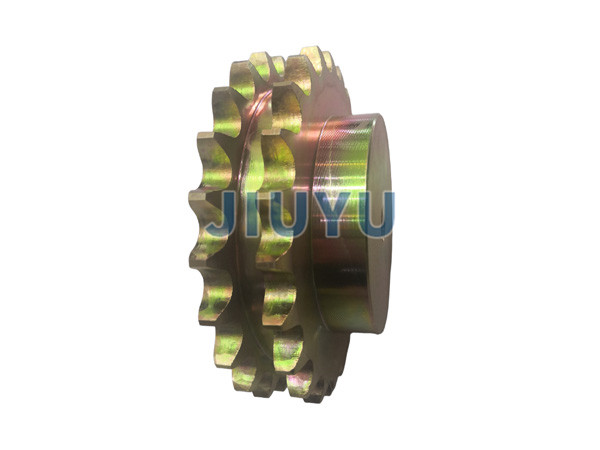
Industrial sprocket is a commonly used component in industrial transmission. Here is an introduction to its related content:
Features
Good transmission efficiency: The meshing transmission between the sprocket and the chain can achieve effective power transmission, and the transmission efficiency is generally around 90% -90%.
Accurate transmission ratio: As long as the number of teeth on the sprocket is determined, its transmission ratio is fixed, which can protect the accurate transmission ratio and make the operation of mechanical equipment more stable and excellent Large bearing capacity: can withstand large loads and torques, suitable for various heavy-duty industrial applications, such as mining machinery, engineering machinery, etc Strong adaptability: able to work normally in harsh working environments such as high temperature, humidity, and dust, with strong adaptability to the environment. For example, in a foundry workshop, sprockets can stably drive in environments with high temperatures and high dust Long service life: Using excellent materials and processing techniques, after heat treatment and other processes, the tooth surface hardness and performance of the sprocket are good, and it can be used for a long timeType
Roller Chain Wheel: Running along a chain formed by rollers connected by pins, it is a common type of chain wheel widely used in transmission equipment, with the characteristics of good transmission efficiency and low noise.
Single pitch sprocket: There is a gap between the teeth, allowing the rolling needles of the chain to fall into each tooth, usually used in conveyor systems that require accurate placement of products Double pitch sprocket: There are also gaps between the teeth, and the pin will fall into each gap, suitable for heavy-duty and high-speed transmission applications Drum sprocket: a thick sprocket that reduces contact pressure and wear by increasing surface area, typically used for heavy-duty and industrial applicationsSelection considerations
Number of teeth: Choose according to requirements such as transmission ratio, speed, and load.
. Under normal working conditions at medium to high speeds, the active sprocket can be selected with 19 teeth or more; The small pitch drive sprocket can use 17 teeth; In the case of impact, 23 teeth or more teeth can be selected Pitch: The center distance between adjacent teeth on a sprocket, which determines the specifications of the chain and the size of the sprocket, and needs to be determined based on factors such as transmitted power, speed, and load Material: Choose according to the usage environment and performance requirements. For example, stainless steel material can be used in corrosive environments; Higher strength alloy steel can be selected in heavy load and high wear environmentsStructural form: Small diameter sprockets are generally made as a whole; Medium diameter sprockets are often made into spoke plates, which can be perforated for easy handling, clamping, and weight reduction; Large diameter sprockets can be made in combination, and the gear ring and wheel core can be made of different materials
Maintenance points
Check the tightness: The tightness of the sprocket should be appropriate. If it is too tight, it will increase power consumption and the bearing is prone to wear.
; If it is too loose, the sprocket is prone to bouncing and detachment. The tightness of the sprocket should be about 2-3% of the center distance between the two sprockets when lifted or pressed down from the middle of the sprocket Confirm installation accuracy: The sprocket should not swing or tilt when installed on the shaft. The end faces of two sprockets in the same transmission component should be located in the same plane, and the deviation should not exceed 1 millimeter when the center distance of the sprockets is less than 0.5 meters; When the center distance of the sprocket is above 0.5 meters, the deviation shall not exceed 2 millimeters Timely replacement of worn parts: After the sprocket is severely worn, a new sprocket and chain should be replaced simultaneously to protect good meshing. You cannot simply replace the new sprocket or chain separately, otherwise it will cause poor meshing and accelerate the wear of the new sprocket or chain Reasonable lubrication: The sprocket should be lubricated in a timely manner during operation, and the lubricating oil needs to enter the fitting gap between the roller and the inner sleeve, with the actual effect as the main working condition to reduce wear Regular cleaning: When the machine is stored for a long time, the sprocket should be removed and cleaned with kerosene or diesel, then coated with engine oil or butter and stored in a dry place


